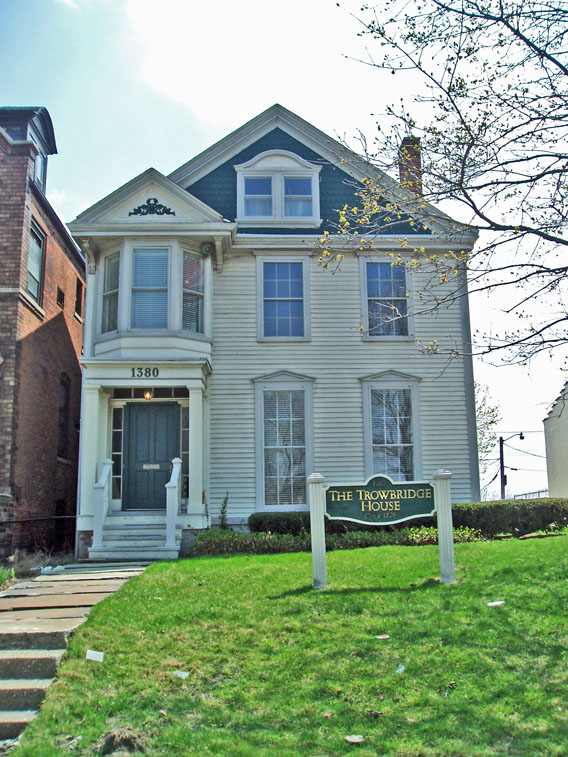

The home pictured above is the oldest residential structure in the city of Detroit. Charles Trowbridge was born in Albany, New York on December 29, 1800. His father died while he was a youth, so he was raised by his mother. In his teen years, he apprenticed with a local businessman to become a merchant but the firm failed while Charles Trowbridge was still a minor. The next year he decided to seek opportunities in the Northwest Territories and came to Detroit. This was a very unusual migration since the Erie Canal did not link Albany to the Great Lakes until 1825.
I do not know how he did so, but Charles Trowbridge secured a federal appointment in Detroit as a Deputy United States Marshal and as a Deputy Clerk of Courts for Michigan. At this point in the early Nineteenth Century, federal marshals took the decennial censuses so Trowbridge was involved in the 1820 count of Michigan. Lewis Cass, who would later be appointed Michigan's territorial governor led an expedition in 1820 to explore the area between the Great Lakes and the headwaters of the Mississippi River, an expedition that explored the Upper Peninsula, and parts of both Wisconsin and Minnesota. Charles Trowbridge had impressed Lewis Cass, so Trowbridge traveled on this expedition, serving as personal secretary to Cass. Lucius Lyon of Grand Rapids was also a member of this group. He played a key role in getting Michigan admitted to the Union as a state in 1836 by promoting the idea that Michigan should get the Upper Peninsula if Ohio were to retain its claim to the Toledo strip. Lyon, and his colleagues, presumably learned about the minerals of the Upper Peninsula on this 1820 trip.
At some point, Trowbridge developed an interest in the numerous Indians who lived throughout Michigan in his era. He became fluent in Cherokee, was appointed as an assistant in the federal government's Indian Department and helped to negotiate treaties with the Winnebago and Menominee tribes.
Solomon Sibley, a lawyer and politician who served as mayor in 1806, was one of the Detroit's most prominent figures in the early decades of the Nineteenth Century. In 1826, Charles Trowbridge married Solomon Sibley's daughter, Catherine Whipple Sibley. The Sibley Home at 976 East Jeffrerson was constructed by Solomon Sibley's, widow, Sarah Spoat Sibley, about twenty-two years after Charles Trowbridge built the home shown above.
At some point, Trowbridge turned his interests to business affairs and politics. He was one of the developers of Detroit, but had interests out-state and was one of the founders of Allegan, Michigan. In 1833, he served as an alderman in Detroit and the next year, when Asian cholera killed many Detroit residents, Trowbridge served as mayor. Trowbridge ran unsuccessfully for governor of Michigan as the Whig candidate in either 1835 or 1837 but lost to the state's first governor, Stevens T. Mason.
In the 1840s and thereafter, Trowbridge devoted himself to banking and to the funding of railroads for Michigan. He was one of the original backers of a line that would run from Detroit to Muskegon. He lived to see the completion of what came to be known as the Detroit and Milwaukee Railroad. Freight, of course, was moved by ship from Muskegon to Milwaukee and points west.
The home you see was built by Trowbridge in 1826. The back and the front of this house are similar. There is a entryway on both sides at the same point. That is, a corridor through the home that links the two entrances. When built, this house faced River Road. That was a road on the eastern side of the home parallel to the present East Jefferson. Perhaps, East Jefferson was not developed when this home was constructed
Charles Trowbridge resided in this home from 1826 until his death in 1883. He lived through important years in the development of Detroit. When he arrived, Detroit was a small village, perhaps a primarily Francophone village, in the remote wilderness. By the time of his death, Detroit was a rapidly growing major manufacturing center linked by rail to all the centers of the nation's commerce. This home remained in the Trowbridge family until 1942. During the Depression years, the structure had been converted into a rooming house, but it was later converted back to a single family residence.
This home is one of many structures included on the National Register's East Jefferson Residential Thematic Resource. If you go to the Historic Sites webpage of the Michigan Department of History, Arts and Libraries, you may find misinformation about this home. That website mentions that this is a brick home and shows a picture of such a residence. I think that picture may show the elegant federal style 1850 Alexander Chene Home at 2861 East Jefferson that was home to Little Harry's Restaurant before it was razed in 1991 to create space for an International House of Pancakes franchise.
Date of construction: 1826
Architect: Unknown
Architectural style: Originally Greek Revival later updated in Victorian style
National Register of Historic Places: Listed May 28, 1976; Building # 76001042
State of Michigan Register of Historic Sites: P4497 Listed July 26, 1974
State of Michigan Historic Marker: None erected
City of Detroit Designated Historic District: Listed March 8, 1982
Use in 2008: Offices
Photograph: Ren Farley April 21, 2008
Description Prepared: February 18, 2009
Return to City of Detroit Historic Designations
Return to East Jefferson Avenue Residential Thematic Resource